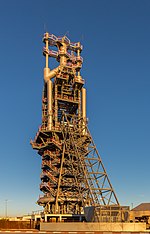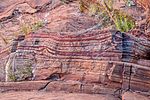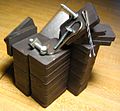Iron oxides are chemical compounds composed of iron and oxygen. Several iron oxides are recognized. Often they are non-stoichiometric. Ferric oxyhydroxides...
10 KB (967 words) - 12:22, 18 November 2024
Iron(III) oxide or ferric oxide is the inorganic compound with the formula Fe2O3. It occurs in nature as the mineral hematite, which serves as the primary...
22 KB (2,154 words) - 00:39, 29 October 2024
Iron(II) oxide or ferrous oxide is the inorganic compound with the formula FeO. Its mineral form is known as wüstite. One of several iron oxides, it is...
7 KB (548 words) - 13:43, 13 August 2024
Iron(III) oxide-hydroxide or ferric oxyhydroxide is the chemical compound of iron, oxygen, and hydrogen with formula FeO(OH). The compound is often encountered...
11 KB (1,227 words) - 00:12, 10 June 2024
Iron(II,III) oxide, or black iron oxide, is the chemical compound with formula Fe3O4. It occurs in nature as the mineral magnetite. It is one of a number...
23 KB (2,169 words) - 13:28, 16 September 2024
Iron oxide nanoparticles are iron oxide particles with diameters between about 1 and 100 nanometers. The two main forms are composed of magnetite (Fe3O4)...
25 KB (2,968 words) - 11:37, 20 February 2024
Thermite (section Iron thermite)
bismuth(III) oxide, boron(III) oxide, silicon(IV) oxide, chromium(III) oxide, manganese(IV) oxide, iron(III) oxide, iron(II,III) oxide, copper(II) oxide, and...
50 KB (5,823 words) - 17:58, 12 November 2024
Iron oxide red is a generic name of a ferric oxide pigment of reddish colors. Multiple shades based on both anhydrous Fe 2O 3 and its hydrates were known...
8 KB (865 words) - 22:13, 16 May 2024
Rust (redirect from Rust (iron oxide))
Rust is an iron oxide, a usually reddish-brown oxide formed by the reaction of iron and oxygen in the catalytic presence of water or air moisture. Rust...
28 KB (3,121 words) - 12:50, 18 November 2024
its oxide layer. Iron forms various oxide and hydroxide compounds; the most common are iron(II,III) oxide (Fe3O4), and iron(III) oxide (Fe2O3). Iron(II)...
150 KB (17,078 words) - 12:22, 24 August 2024
Limonite (redirect from Brown iron ore)
Limonite (/ˈlaɪməˌnaɪt/) is an iron ore consisting of a mixture of hydrated iron(III) oxide-hydroxides in varying composition. The generic formula is frequently...
15 KB (1,669 words) - 16:49, 7 February 2024
negatively charged ion). Iron silicate, Fe2SiO4, the mineral fayalite, is one of many examples of a ternary oxide. For many metal oxides, the possibilities...
12 KB (1,561 words) - 04:17, 27 June 2024
Nitric oxide (nitrogen oxide or nitrogen monoxide) is a colorless gas with the formula NO. It is one of the principal oxides of nitrogen. Nitric oxide is...
31 KB (2,944 words) - 17:32, 16 November 2024
An acidic oxide is an oxide that either produces an acidic solution upon addition to water, or acts as an acceptor of hydroxide ions effectively functioning...
5 KB (580 words) - 02:09, 29 April 2024
Hematite (redirect from Specular iron)
Hematite (/ˈhiːməˌtaɪt, ˈhɛmə-/), also spelled as haematite, is a common iron oxide compound with the formula, Fe2O3 and is widely found in rocks and soils...
23 KB (2,343 words) - 20:38, 7 October 2024
Blast furnace (redirect from Iron blast furnace)
carbon monoxide is the reducing agent for the iron ore and reacts with the iron oxide to produce molten iron and carbon dioxide. Depending on the temperature...
63 KB (7,442 words) - 15:27, 19 November 2024
reduction and subsequent oxidation of iron ions, particularly the reduction and oxidation between Fe3+ and Fe2+. The ferrites, or iron oxide, begins in the form...
4 KB (632 words) - 16:34, 16 September 2024
Corrosion (redirect from Rusting of iron)
electrochemical oxidation of metal in reaction with an oxidant such as oxygen, hydrogen, or hydroxide. Rusting, the formation of red-orange iron oxides, is a well-known...
50 KB (6,488 words) - 19:29, 22 October 2024
Copper(II) oxide or cupric oxide is an inorganic compound with the formula CuO. A black solid, it is one of the two stable oxides of copper, the other...
10 KB (829 words) - 15:20, 14 September 2024
Iron oxide adsorption is a water treatment process that is used to remove arsenic from drinking water. Arsenic is a common natural contaminant of well...
2 KB (320 words) - 18:21, 26 October 2023
units of sedimentary rock consisting of alternating layers of iron oxides and iron-poor chert. They can be up to several hundred meters in thickness and...
67 KB (7,125 words) - 11:06, 24 September 2024
needed] Two types of iron oxide contrast agents exist: superparamagnetic iron oxide (SPIO) and ultrasmall superparamagnetic iron oxide (USPIO). These contrast...
45 KB (4,737 words) - 13:08, 8 October 2024
Iron ores are rocks and minerals from which metallic iron can be economically extracted. The ores are usually rich in iron oxides and vary in color from...
55 KB (7,043 words) - 04:37, 14 November 2024
Iron oxide copper gold ore deposits (IOCG) are important and highly valuable concentrations of copper, gold and uranium ores hosted within iron oxide...
22 KB (2,879 words) - 18:49, 18 January 2024
Ferrite (magnet) (redirect from Α-iron)
A ferrite is one of a family of iron oxide-containing magnetic ceramic materials. They are ferrimagnetic, meaning they are attracted by magnetic fields...
34 KB (3,743 words) - 01:45, 12 November 2024
Sienna (category Iron oxide pigments)
Siena, meaning "Earth of Siena") is an earth pigment containing iron oxide and manganese oxide. In its natural state, it is yellowish brown, and it is called...
13 KB (1,612 words) - 16:27, 28 October 2024
Non-stoichiometric compound (redirect from Nonstoichiometric oxide)
sulfides have non-stoichiometric examples; for example, stoichiometric iron(II) oxide, which is rare, has the formula FeO, whereas the more common material...
17 KB (1,474 words) - 23:01, 6 February 2024
Smelting (redirect from Iron smelting)
base metal. Examples: Iron oxide becomes metallic iron at roughly 1250 °C (2282 °F or 1523 K), almost 300 degrees below iron's melting point of 1538 °C...
35 KB (3,881 words) - 03:03, 11 November 2024
impurities, such as iron and titanium. An extremely rare δ form occurs as the mineral deltalumite. The field of aluminium oxide ceramics has a long history...
36 KB (3,591 words) - 07:25, 11 November 2024
























